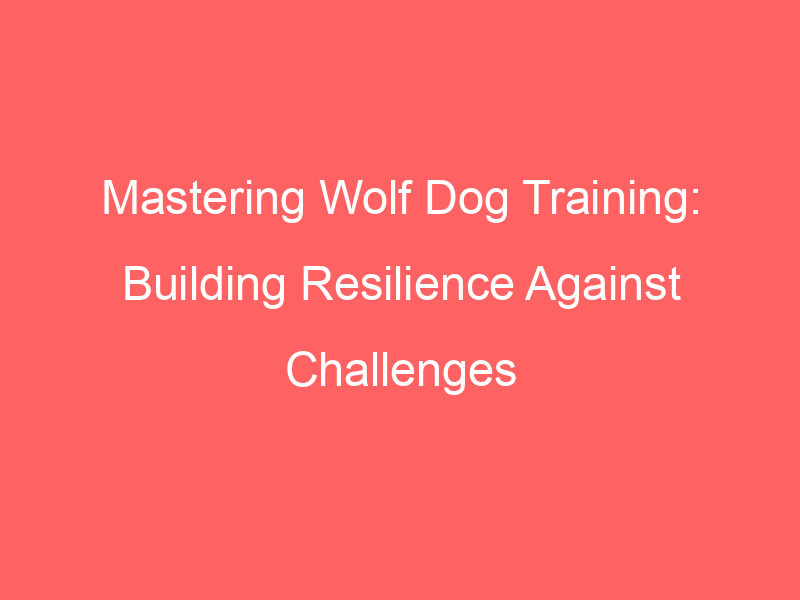Introduction to Wolf Dog Training
Wolf dogs, a unique blend of domestic dog and wild wolf, are fascinating creatures. They are known for their intelligence, strength, and loyalty. However, their wild instincts can make them a challenge to train. This is why understanding their unique characteristics and the importance of specialized training is crucial for any wolf dog owner.
- Understanding the Unique Characteristics of Wolf Dogs
- Importance of Specialized Training for Wolf Dogs
Wolf dogs are not your typical pets. They inherit traits from both their wolf and dog ancestors, which makes them unique. They are highly intelligent, independent, and have a strong prey drive. These traits can make them more challenging to train than other dogs.
Unlike domestic dogs, wolf dogs are not naturally inclined to please their human companions. They are more likely to act on their own instincts. This can lead to behaviors that are often misunderstood, such as aggression or fearfulness. Understanding these unique characteristics can help you approach training in a way that respects their natural instincts and promotes a strong bond between you and your wolf dog.
Due to their unique characteristics, wolf dogs require specialized training. Traditional dog training methods may not be effective with them. Instead, they need a training approach that respects their wild instincts and promotes positive behaviors.
Specialized training for wolf dogs often involves techniques such as positive reinforcement, socialization, and consistency. It’s also important to start training as early as possible to help your wolf dog understand what is expected of them.
Without proper training, wolf dogs can become fearful or aggressive. But with the right approach, they can become loyal and loving companions. This is why understanding the importance of specialized training for wolf dogs is so crucial.
In conclusion, training a wolf dog is not a task to be taken lightly. It requires understanding, patience, and a specialized approach. But the rewards of having a well-trained wolf dog as a companion are well worth the effort.
Understanding Wolf Dog Behavior
Wolf dogs are unique creatures that exhibit a blend of traits from both wolves and domestic dogs. Understanding their behavior is crucial for effective training and building a strong bond with them. Let’s delve into the common traits and behaviors of wolf dogs and how they differ from other breeds.
- Common traits and behaviors of wolf dogs
Wolf dogs are known for their intelligence, independence, and strong pack instincts. They are highly energetic and require plenty of physical and mental stimulation. Here are some common traits and behaviors:
| Traits | Behaviors |
|---|---|
| Intelligence | They are quick learners and problem solvers. |
| Independence | They prefer to explore and make decisions on their own. |
| Pack Instincts | They form strong bonds with their pack and are protective of them. |
| Energy | They require plenty of exercise and mental stimulation. |
- How wolf dog behavior differs from other breeds
Wolf dogs are not your average dogs. They have unique behaviors that set them apart from other breeds. Here are a few differences:
| Wolf Dogs | Other Breeds |
|---|---|
| They have a strong prey drive and can be a challenge to train. | Most breeds have a lower prey drive and are easier to train. |
| They are more independent and may not always obey commands. | Most breeds are more obedient and eager to please their owners. |
| They require a lot of physical and mental stimulation. | Most breeds require less exercise and mental stimulation. |
Understanding these behaviors is the first step towards effective wolf dog training. Remember, every wolf dog is unique and may not exhibit all these traits. The key is to observe and understand your wolf dog’s individual behavior.
Overcoming Obstacles in Wolf Dog Training
Training a wolf dog can be a challenging task due to their unique behavioral traits. However, with the right knowledge and approach, these obstacles can be overcome. Let’s delve into some of the common obstacles encountered during wolf dog training and how to overcome them.
Identifying Common Wolf Dog Training Obstacles
Understanding the challenges you may face while training your wolf dog is the first step towards overcoming them. Here are some of the most common obstacles:
- Understanding the wolf dog’s natural instincts
- Addressing fear and anxiety in wolf dogs
- Overcoming aggression and dominance issues
Wolf dogs have a strong instinctual behavior due to their wolf heritage. These instincts can include a high prey drive, a desire to roam, and a natural wariness of strangers. Understanding these instincts is crucial to successful training. For example, a wolf dog’s high prey drive means they may be more interested in chasing a squirrel than listening to your commands. By recognizing this, you can adjust your training methods accordingly.
Wolf dogs can be more sensitive to changes in their environment compared to other breeds. This sensitivity can lead to fear and anxiety, which can hinder training. It’s important to create a safe and stable environment for your wolf dog. This includes providing them with a consistent routine and slowly introducing them to new experiences to help reduce their anxiety.
Some wolf dogs may display signs of aggression or dominance, particularly towards other dogs. This behavior can be challenging to manage, especially if you have other pets. However, with consistent training and socialization, these issues can be mitigated. It’s important to establish yourself as the pack leader and to correct aggressive behavior immediately to prevent it from becoming a habit.
In the next section, we will discuss strategies for overcoming these obstacles and successfully training your wolf dog. Stay tuned!
Strategies for Overcoming Training Challenges with Wolf Dogs
Training a wolf dog can be a challenging task due to their unique behavioral traits. However, with the right strategies, you can overcome these challenges and establish a strong bond with your wolf dog. Here are some effective strategies that can help you in this regard:
- Using Positive Reinforcement Techniques
- Establishing a Consistent Training Routine
- Seeking Professional Help When Necessary
Positive reinforcement is a powerful tool in training wolf dogs. This technique involves rewarding your wolf dog for good behavior, which encourages them to repeat it. Rewards can be in the form of treats, praise, or extra playtime. For instance, if your wolf dog sits on command, you can give them a treat as a reward. This will make them associate sitting on command with receiving a treat, and they will be more likely to do it again.
Consistency is key when it comes to training wolf dogs. Establishing a regular training schedule can help your wolf dog understand what is expected of them. This routine should include regular exercise, feeding times, and training sessions. It’s also important to be consistent with your commands and the way you reward your wolf dog. This will help them understand what behaviors are rewarded and what behaviors are not.
While many wolf dog owners successfully train their pets at home, there may be times when professional help is necessary. If your wolf dog is showing signs of aggression, fear, or other behavioral issues, it may be best to seek the help of a professional dog trainer or behaviorist. These professionals have the experience and knowledge to handle these issues and can provide you with the tools and techniques to manage them effectively.
In conclusion, overcoming training challenges with wolf dogs requires patience, consistency, and the right strategies. By using positive reinforcement techniques, establishing a consistent training routine, and seeking professional help when necessary, you can create a positive and rewarding training experience for both you and your wolf dog.
Building Resilience in Wolf Dogs
Resilience is a key trait that can help wolf dogs adapt to various situations and overcome challenges. By building resilience, we can help these magnificent creatures lead happier, healthier lives. Let’s explore how we can foster resilience in wolf dogs through training.
Fostering Resilience in Dogs through Training
Training plays a significant role in building resilience in wolf dogs. It not only helps them learn new skills but also boosts their confidence and adaptability. Here are two effective ways to foster resilience through training:
- Teaching resilience through exposure to various situations
- Building confidence through successful training exercises
Exposing your wolf dog to a variety of situations can significantly enhance their resilience. This could include different environments, people, and other animals. Gradual exposure helps them understand that new experiences are not necessarily threatening, thereby reducing anxiety and fear. For example, you might start by taking your wolf dog to a quiet park, then gradually introduce them to busier settings.
Successful training exercises can greatly boost a wolf dog’s confidence, thereby fostering resilience. Start with simple commands like ‘sit’ or ‘stay’, and gradually move on to more complex tasks. Remember to reward your wolf dog for each success, whether it’s with a treat, praise, or a favorite toy. This positive reinforcement not only helps them learn but also builds their confidence, making them more resilient in the face of new challenges.
Building resilience in wolf dogs is a gradual process that requires patience and consistency. But with the right approach, you can help your wolf dog become more confident and adaptable, ready to face whatever comes their way.
Resilience in Animal Training: Case Studies
Let’s delve into some real-life examples that illustrate the power of resilience in wolf dog training. These case studies will provide a clearer understanding of how resilience can be fostered in these magnificent creatures, leading to happier, healthier, and more confident wolf dogs.
- Case study 1: Overcoming fear of strangers in a wolf dog
- Case study 2: Building confidence in a previously abused wolf dog
Meet Max, a wolf dog who had a deep-rooted fear of strangers. Max’s fear was so intense that he would hide or act aggressively when a stranger approached. His trainer, using a combination of patience, positive reinforcement, and gradual exposure, helped Max overcome his fear.
Initially, the trainer would have a friend stand at a distance where Max felt comfortable. Over time, the friend slowly moved closer, always ensuring Max was at ease. The trainer rewarded Max with treats and praise whenever he remained calm as the friend approached. After several weeks, Max was able to comfortably interact with strangers, demonstrating the power of resilience training.
Next, we have Bella, a wolf dog who was previously abused and lacked confidence. Bella’s trainer used a variety of techniques to build her confidence, including positive reinforcement, exposure to new experiences, and consistent training routines.
One of the key strategies was to expose Bella to new situations in a controlled and safe environment. For example, Bella was introduced to new people and dogs in a controlled setting, where she could observe from a distance and gradually get closer as she felt comfortable. This helped Bella build confidence and resilience, proving that with patience and the right training methods, even a previously abused wolf dog can thrive.
These case studies show that resilience training can help wolf dogs overcome their fears and build confidence. It’s a testament to the power of patience, understanding, and consistent, positive training methods.
Wolf Dog Training Methods
Training a wolf dog can be a challenging yet rewarding experience. It requires patience, consistency, and the right techniques. In this section, we will explore some of the most effective methods for training wolf dogs.
Effective Training Techniques for Wolf Dogs
There are several techniques that have proven to be effective in training wolf dogs. These methods are not only efficient but also promote a positive relationship between the trainer and the wolf dog. Let’s delve into these techniques:
- Using reward-based training methods
- Implementing obedience training
- Utilizing socialization techniques
Reward-based training is a powerful method for teaching your wolf dog new behaviors. This technique involves rewarding the dog with treats, praise, or a favorite toy whenever it performs the desired action. For instance, if you are teaching your wolf dog to sit, you would give it a reward each time it successfully sits on command. This method is effective because it motivates the dog to repeat the behavior in anticipation of the reward.
Obedience training is crucial for any dog, but it’s especially important for wolf dogs due to their strong-willed nature. This training involves teaching your dog basic commands such as “sit”, “stay”, “come”, and “leave it”. Consistent obedience training helps establish your authority and ensures your wolf dog understands what is expected of it.
Socialization is a key aspect of wolf dog training. This involves exposing your wolf dog to a variety of people, environments, and other animals to help it become comfortable in different situations. Regular socialization can help reduce anxiety and aggression in wolf dogs, making them more manageable and happier overall.
Remember, training a wolf dog takes time and patience. But with these effective techniques, you can help your wolf dog become a well-behaved and confident companion.
Advanced Wolf Dog Training Techniques
Once your wolf dog has mastered the basics, it’s time to move on to more advanced training techniques. These methods will not only keep your wolf dog mentally stimulated but also help them become more agile and enduring. Let’s explore these advanced techniques in detail.
- Teaching Advanced Commands and Tricks
- Training for Agility and Endurance
Teaching your wolf dog advanced commands and tricks is a great way to keep them mentally stimulated and engaged. It’s also a great way to strengthen your bond with your pet. Some advanced commands you can teach your wolf dog include “stay”, “heel”, “fetch”, and “roll over”. Remember, patience is key when teaching these commands. It might take some time for your wolf dog to master these tricks, but the end result is worth the effort.
Wolf dogs are naturally agile and have great endurance. However, with proper training, you can enhance these traits even further. Agility training involves teaching your wolf dog to navigate through obstacle courses, which can include jumps, tunnels, and weave poles. This type of training not only improves their physical fitness but also their mental agility.
Endurance training, on the other hand, involves activities like long-distance running or swimming. This type of training helps to build your wolf dog’s stamina and endurance, making them more fit and healthy. Remember, always start slow and gradually increase the intensity of the training to avoid overworking your pet.
In conclusion, advanced training techniques are a great way to keep your wolf dog mentally and physically stimulated. They also help to strengthen the bond between you and your pet. Remember, patience and consistency are key in any training regimen. Happy training!
Conclusion: Mastering Wolf Dog Training
As we conclude our exploration of wolf dog training, it’s crucial to remember that this journey is not a sprint but a marathon. It requires dedication, patience, and consistency. Let’s recap the key takeaways and reiterate the importance of patience and consistency in training.
- Recap of key takeaways in wolf dog training:
- The importance of patience and consistency in training:
Understanding your wolf dog’s behavior is the first step in effective training. Remember, these animals have a strong pack mentality, and establishing yourself as the pack leader is essential. Overcoming obstacles in training, such as fear or aggression, requires patience and a deep understanding of your pet’s needs and instincts. Building resilience in your wolf dog is a continuous process, and the training methods you employ should be tailored to your pet’s unique personality and needs.
Patience and consistency are two vital virtues in wolf dog training. Training a wolf dog is not a one-day affair. It takes time and a lot of repetition for your pet to understand and follow commands. Consistency in your commands and actions helps your pet understand what is expected of them. Remember, inconsistent actions or commands can confuse your pet and make the training process more challenging.
Mastering wolf dog training is a rewarding journey that strengthens the bond between you and your pet. It’s a journey filled with trials and triumphs, but the end result – a well-trained, obedient, and happy wolf dog – is well worth the effort.
Remember, “Patience and consistency in training are not just about teaching your pet commands. It’s about teaching them how to be a part of your family.” – Anonymous








